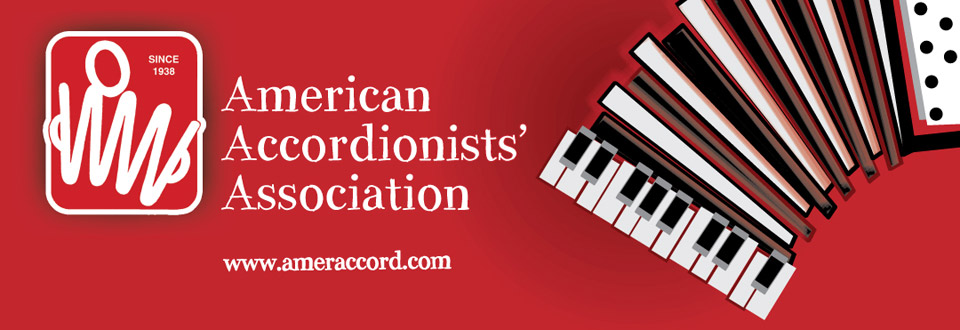 |
The American Accordionists’ Association turns 80!!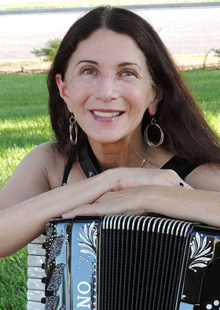 In March of 2018, the American Accordionists’ Association (AAA) will turn 80 years old. We hope to see all of you this summer in beautiful Alexandria, Virginia, where we will celebrate this special milestone! As the organization’s historian, I will be writing monthly articles on events that led up to the creation of the AAA, some of its influential members, as well as special events throughout the decades, and more. In March of 2018, the American Accordionists’ Association (AAA) will turn 80 years old. We hope to see all of you this summer in beautiful Alexandria, Virginia, where we will celebrate this special milestone! As the organization’s historian, I will be writing monthly articles on events that led up to the creation of the AAA, some of its influential members, as well as special events throughout the decades, and more.Below is the 5th article. Links to the other monthly articles below that. |
| Joan Grauman Morse, AAA Historian |
Growing up in the accordion schools: The 1950s through the 1970s |
I didn't study the accordion as a child, I studied the piano. I began my piano lessons in 1960 at the age of 6, and eventually majored in music education and piano performance. My piano teacher was fabulous, and I am ever so grateful for the years I spent with this warm, wonderful woman who paved the way for me to find the greatest musical joy in my life….. the piano accordion! This is not how life was in the accordion schools of that era!! It was a very different world in those years in the US. Families often had just one car, most mothers stayed home to raise their children, and families did a lot together – a lot! For the children, there wasn’t the pressure to play every sport offered at school, no computers or cell phones to distract them, there was just lots of wonderful free time to spend in their beloved accordion bands with their friends – their second family! Plus, most of the parents would get involved in their kids’ accordion education. They held huge fundraisers so that buses could be rented to haul the entire band to AAA competitions, and the families’ annual vacations were very often the AAA festivals and competitions!! This article will focus on the reflections of a few of those who did have the opportunity and good fortune to grow up in the precious environment of the accordion schools from the 1950s through the 1970s – a magical time in our country that, sadly, we will most likely never see again. The friendships made, the lessons learned, and the beautiful memories have lasted a lifetime for them, and they continue to give back to the instrument that has always meant so much to each of them. So, sit back and be prepared to read several “mini articles” – all beautifully filled with terrific memories of a very special time in our accordion history! Thank you Joan Cochran Sommers, Liz Finch, Joe Cerrito, Mark Yacovone, Linda Soley Reed, Rita Barnea, Karen Malan-Uribe and Marilyn O’Neil for your contributions to this article! |
| 55 Accordions in Concert - the 1st UMKC Accordion Orchestra Concert in the Spring of 1961 |
Professor Joan Cochran Sommers not only grew up playing with groups of young accordionists, she created her own wonderful accordion school for young people, and then taught accordion at the college level and took her stellar orchestras all over the world to perform. Joan retired from teaching at the University of Missouri, Kansas City (UMKC) Conservatory of Music in 2000. She is a world renowned conductor and continues to write outstanding arrangements for accordion orchestras. Here are Joan’s words: "Since the age of 9 when I began to learn how to play the accordion, I have been participating in group activities. My first lesson on the 12 bass accordion was as a member of a class with 5 or 6 young people. I absolutely loved it, although before that I had no idea of what an accordion even was. When I was about 5 or 6, there was a neighbor across the street who had a piano and she would let me come over and “mess around” with it, something I found to be really fun and interesting. Later on as a student in a first grade class of many students in a very small town, I was introduced to the Tonette and began learning how to read a few notes and count correctly. I also learned how to make a small music stand out of a clothes hanger which could be placed on a table and hold my music pages. Again, I found it really enjoyable and I looked forward to that class very much. Of course this didn’t last very long, once everyone had purchased the small wind instrument, the salesman was gone and the teachers in the school perhaps had no idea of what to do next, so the classes eventually ended. Later my parents and my younger brother and sister moved to a much bigger town and a salesman knocked on our door and asked if we would like to play the accordion. My mother and father agreed to let my brother and me take lessons, not private lessons but class lessons. So off we went with our two 12 bass accordions and I can tell you that from the very first class I was hooked on the accordion! I absolutely loved it! Part of the reason I loved it was I was in this class with other young students and each of us were learning from our teacher but also from each other. We played as a soloist sometimes but we also got to play together whatever our current weekly lesson was. It was really neat and exciting to see who could be the best in the class and, as I remember it, some of us would always jump ahead and try to learn something more than what our teacher had assigned. We were trying to impress not only the teacher but others in the class as well as our parents who were also allowed to sit in the room and listen to us. Not too long after our parents purchased our first 120 bass instruments the members of our class were invited to join an accordion band. We went once a week for our class lesson and once a week to our band lesson. In band we learned how to play some pieces with several parts and to follow a conductor and listen to each other’s parts. Once in a while our conductor would ask a few of us to play a solo. Sometimes people volunteered before they were really ready to play their piece for anyone, but in listening to their struggles some of us also gained courage and decided we might volunteer to play next time. As the years went by, at the age of 14, I was asked, along with one of the other members of my accordion class, to teach a small class of beginners. We both said yes and jumped at this chance to earn a few dollars and continue on this ever interesting and enjoyable accordion journey. Not long after, I began to conduct a small accordion group. We began competing and performing. Throughout all these experiences, even as a very young participant, I learned that I could have fun being with others, whether they were very good players or, unfortunately, sometimes not so talented. But all of us learned from each other; our knowledge came from not just the teacher or the conductor of the band. We helped each other learn about more than music, we also learned how to be real friends and to give courage and support to those friends. Why do I believe group activities are important, probably even more important today than ever before? For one thing, all of us need friends and group activities help provide those friends. We learn easier in a group since we are not always put on the spot for the answer. We learn from listening to others. In a group of 2 or 52 we learn to be responsible for the part we are given to play. We learn that it is important for us to be able to trust each other. We learn why we need each other and to know that the person sitting next to us can be relied upon, either to lead us or to follow. We are learning important life lessons, not just music. Competitions give us the chance to prove ourselves to others that our work as a group has been worthwhile, whether we win or not. We have the opportunity to hear groups which are sometimes better than we are, but sometimes we hear others not as well prepared, and we learn from those experiences. Winning is great, of course, but not earning a first place is easier when we have had the chance to hear those who did play better or played a much more difficult piece, and we learn from it and vow to do better next time; we are inspired. In my early days of teaching and conducting, there were literally thousands of accordion students, something which is not exactly the same today. However, it is still important for us to play in groups. Not every student taking music lessons, regardless of the instrument, will become a soloist, but almost everyone learning to play the accordion can continue to make wonderful music together throughout their lives. That is one of the most glorious reasons for a person to play the accordion! We can play all kinds of music. We can play in parades and at holiday celebrations, but we can also play at far more serious occasions and everything in between. Soloists at some point often must give up, but group players can continue for many, many years to enjoy being together and playing satisfying repertoire. Groups can learn about and perform an unlimited amount of repertoire which simply is not possible to play as a solo. Today, with the number of homes where both parents work full time or where this is just one parent, accordion groups become ever more important as a “family” for young accordion players. They are too busy keeping up with their accordion group and will not want to disappoint their friends by getting into troubles so often associated with young people today. I have always believed in the power of accordion groups and I could relate many stories proving my reasons for believing. The accordion is ideally suited for group work, perhaps more so than any other musical instrument." |
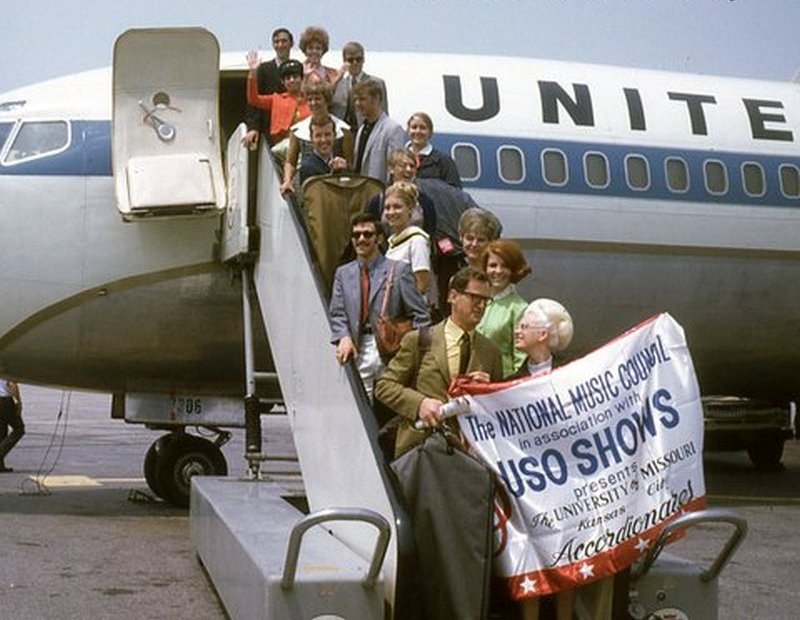 1969 USO Tour to Germany, Liz Finch (in white) and Joan Cochran Sommers holding the banner.
1969 USO Tour to Germany, Liz Finch (in white) and Joan Cochran Sommers holding the banner. |
Liz Finch had the good fortune as a child to live in the Kansas City area and study the accordion with Joan Sommers. Now living in Los Angeles, CA, she works as a music orchestrator and copyist. Liz describes the joys of growing up in the accordion bands: "Growing up in the 50s and 60s meant that in the United States you could have a lot of fun playing the accordion. It was very popular and still part of the general popular music scene. I started like many other young children at a local accordion school that signed up students to take lessons – and play in a band of all accordions. I was 7 years old when I was one of approximately 200 students (of about the same age) who played in the “Stars of Tomorrow” Cavalcade of Accordion Bands at the World War II Memorial Building in Kansas City, Missouri. There were six different accordion studios represented on the program. Many Mid-America festivals and bands later, I found my way to the Conservatory of Music to study with Joan Cochran (now Joan Sommers) and joined the 55 - piece Conservatory Accordion Orchestra with my younger sister. Now a teenager, joining many other students my age in such a challenging and exciting ensemble was fun, both musically and socially. There were many other siblings in the group besides my sister and me and, of course, being teenagers, we had crushes on other members off and on (a couple of brothers in the group come to mind!). We worked very hard to maintain a high level of excellence and performed concerts all around the Kansas City area. A highlight for the Conservatory Accordion Orchestra was in 1964 when the entire group traveled to New York to participate in the AAA orchestra competition held at the New York World’s Fair. The elite of accordion professionals were there and seeing the lists of U.S. championship competitors that year who went on to become outstanding musicians and leaders in the field is impressive (Steve Dominko, Mary (Tokarski), Julie (Cardona) and Walter Kasprzyk, Donna Dee Anderson (Ray) Betty Jo Stubblefield (Simon), Eddie Monteiro and Frank Busso, to name a few. All of this had a tremendous impact on me and led to me to continue playing accordion in ensembles. The 1969 USO tour with our 13-piece group from the UMKC Conservatory (led by Joan Cochran Sommers) has to be one the best memories of my life. We watched the moon landing in Stuttgart, Germany together that summer while on tour. We played a concert six days a week for over two months that summer. There are four married couples from that group and we all are still very close friends! Being a part of a musical group always appealed to me and even led to my career as an orchestral orchestrator in Los Angeles. And I still like to play in accordion orchestras!" |
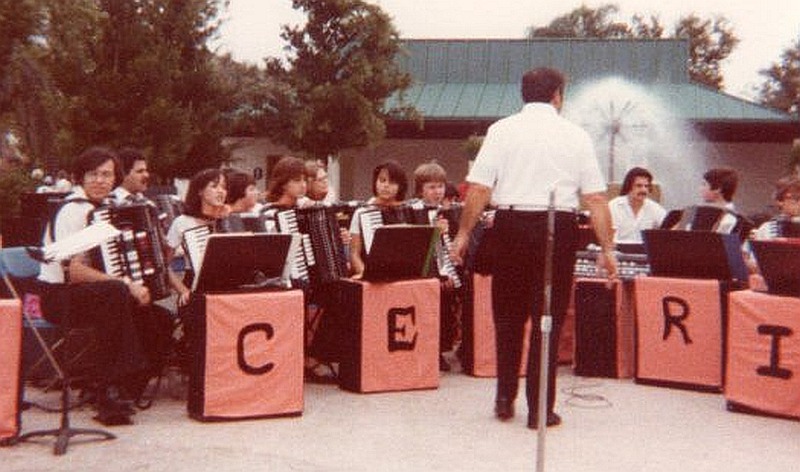 |
| Cerrito Music School Orchestra under the direction of Joe Cerrito, performing at Sea World, Florida, 1978. |
The Joe Cerrito School of Music was another place where happy accordionists flocked to learn, work, play, socialize – and to work some more! Joe tells me about those years and how much fun he had with these kids whom he treated just like his own children. He worked them hard, and they flourished in this strict, yet nurturing and loving environment. Joe encouraged friendships among his students. This created a huge, happy group of young musicians, eager to learn and participate in duos, ensembles, bands and the AAA competitions. Joe always encouraged them to feel as proud of the success of one of their studio friends as they felt for their own successes. "Just do your personal best – this is all you have to do", were Joe’s words to his students as they would prepare to compete. Joe's children and his students who I interviewed (for my article on Joe Cerrito in the 2016 AAA Festival Journal) all said that their experience in Joe's music school taught them everything they needed to succeed in life: responsibility, how to reach for goals, "it is always worth it to do the work", and how to get along with and encourage other people. One of Joe’s former students, Mark Yacovone, a professional musician and owner of a software company summed it up well. "We were a tightknit group. We loved our trips to the AAA competitions, the studio camaraderie… but mostly, we remember Joe. His nurturing attitude was unwavering. He had a major effect on my life. Just about EVERYTHING I learned about music -- and my passion for learning, I attribute it all to Joe!" |
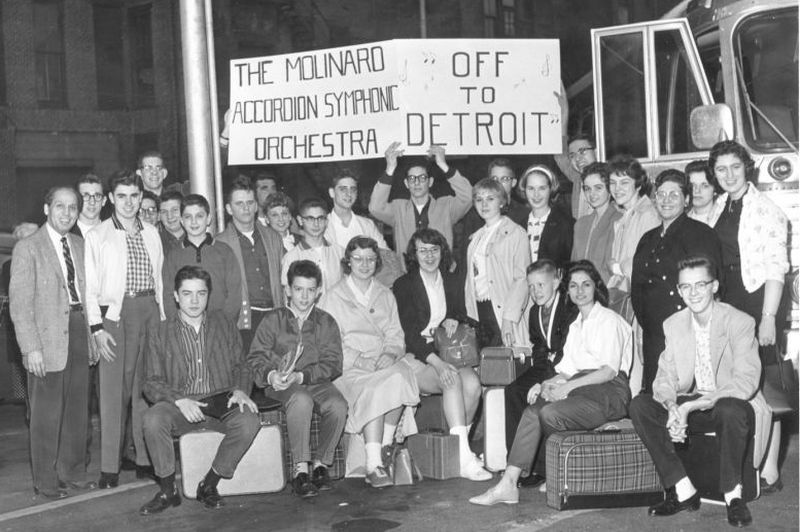 |
| Rudy Molinaro Accordion School (circa 1959) travels to Detroit, Linda Soley Reed seated with dark sweater. |
The accordion teachers had a major effect on their students. They were their role models. They were their "parents". Their pride in their students brought out the best in these kids. AAA 2nd Vice-President, and former AAA President, Linda Soley Reed studied with Rudy Molinaro in Bridgeport, Connecticut. Rudy's pride in his students was also unwavering and he, like Joe Cerrito, treated all of his students like his own children. Here are Linda's memories of the years at the Molinaro Studio: "I started playing accordion at age 7 and just after my 10th birthday, my teacher was drafted into the United States Army. It was not the end of the road for me because he sent me to his teacher, the great Rudy Molinaro. After a brief audition, I was accepted into the folds of the Rudy Molinaro Accordion School. The building was located in downtown Bridgeport, Connecticut right alongside the railroad tracks. The building was huge and there was no elevator – the studio was on the third floor! It wasn’t long after I started studying with Rudy that he asked me to play in the accordion orchestra. Rehearsals were on Sunday afternoons every week and thus began friendships that still exist today. This way to never, never land…. was the writing on the wall when you entered the building. The fourth floor of the building was condemned which meant there was no electricity. We weren’t supposed to go up to the 4th floor but of course we did. It was an elegant old ballroom right out of the 20s or 30s. An elegant bandstand with chandeliers, and artist dressing rooms lined the entire hallway leading to the once back entrance of the ballroom. We played hide and seek in all the little rooms – and again there was no electricity. Of course Rudy could hear everything because his teaching room was directly below. When we heard him on the stairs, we would scatter. The studio was our playground. There were at least 15-16 of us that were all the same age, or close. We travelled together, we went to parties and picnics at someone’s house, drove together into NYC to hear Magnante, Biviano or Carrozza and on several occasions, our orchestra also performed. Rudy always took us all to his favorite restaurant, The Venetian Garden. He would call the owner, Nick and say, “Nick, stay open I'm bringing 8 kids over for dinner." And it wasn’t just "us." We chartered a bus to take us to Detroit and there we met Tony Dannon's kids at Modern Accordion Studio (equally as mischievous) – I will always remember Boblo Island – an amusement park in the middle of the lake; in Washington DC it was Carmelo Pino's students who joined the ranks of the mischief-makers who were always in the pool and not where they were supposed to be, and in Massachusetts, Jazz artist Maurice (Mo) Cargiulo had a group of students our age - more trouble afoot as we helped them cook sausage in the hotel room. In Rhode Island, we met up with some of Tulio Gasperini's students and also Joe Cerrito's gang. But Joe was very cautious and kept his students in tow all the time. The bottom line was that we all had "fun." We mimicked each other's playing and bad habits and laughed until tears rolled down our cheeks as Stephen (Dominko) mimicked various players especially those that made outrageous sounds when they were performing. A bunch of kids travelling alone, we always had chaperones - Carmela Rivelli was the "godmother" to all of us and made sure we kept in line and stayed in our rooms. If there was trouble, Rudy would come along and raise havoc. As we got older, relationships formed – some that lasted forever, others that fell by the wayside. We all got older and wiser (well sort of…) we drifted into other careers and other friends. But the memories of those years at "the studio" live in our hearts and minds and I will cherish them forever." |
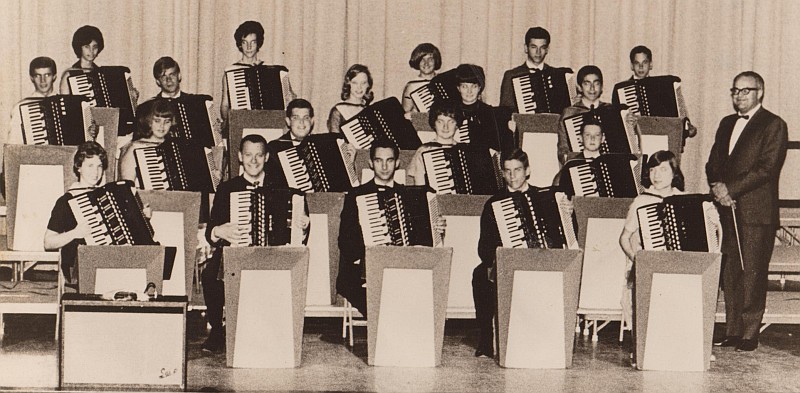
|
| The Sano Symphony under the direction of Eugene Ettore (circa 1963), Rita Barnea seated right front. |
AAA Governing Board member and editor of Accordion USA, Rita Barnea studied accordion in Irvington, New Jersey. Her memories of the years spent at the Major Music Accordion Studio are all joyful ones. Sadly, Rita’s beloved accordion teacher Eugene Ettore was killed in a car accident in the 1980s. Rita still works tirelessly to keep his memory alive and to educate the accordion world about Ettore's brilliant and beautiful compositions. Here are Rita’s words: "I began accordion lessons at the age of eight at Major Music Accordion Studio in Irvington, NJ. My mother would bring me there each week for an accordion lesson and my father would take me to band practice one evening a week. Not only was it a supportive, educational, and fun environment for a young person to develop music skills but it was also a nurturing and friendly place where lifelong friendships were formed. Competition, encouragement, and striving to be as good as your friend on the next higher level was all a positive influence in developing good character traits as well as musical skills. The band groups began with the Freshman Band for the youngest players with age appropriate music. As the student developed technical and musical skills, there were graded ensemble groups to strive for: Junior Band, Intermediate Band, Senior Band leading to the highest level which was the Sano Symphony led by teacher/composer Eugene Ettore. Of course, owning a Sano accordion was also a requirement which was part of the business of accordion studios in the USA at that time. Each promoted their own brand of accordion. We all entered competitions in the New Jersey Accordion Teachers Association competition held each March, and the AAA competition in NYC each November. It was exciting to be given a new piece to work on and it was very motivational to attend the competitions, hear the categories, and the concerts in the evening which frequently featured people such as Carmen Carrozza, Madalena Belfiore, Pietro Deiro, and many more well-known accordionists of the times. Major Music held a formal Spring Concert each year with all groups performing. There was also a very special Christmas party held at a catering hall each year. Refreshments, prizes, and music were provided for all students and parents by owner Louis Iorio. Miss Divizio strolled around with a 12 bass accordion playing Christmas songs. Santa appeared and it was a delightful memorable evening rewarding us for our dedication to practicing. Each summer there was a special day with buses taking us all to Bertrand's Island Amusement Park at Lake Hopatcong, NJ. So exciting that each of us were given an envelope with money and tickets to enjoy the rides and refreshments -- rewards for all our many hours of practicing our beloved accordion! We all loved going to Major Music where everyone was encouraging and brought out the best in each student. It was an innocent time, before cable TV, cell phones, computers and all the technology that does not bring us together as it claims to do. We would get together in a warm, nurturing environment of music and fun and yes, it had a life-long effect on me. I wish the accordion studios of those times were here today. It would certainly foster great values and develop in students the idea that hard work and competition can exist in a friendly encouraging environment.” |
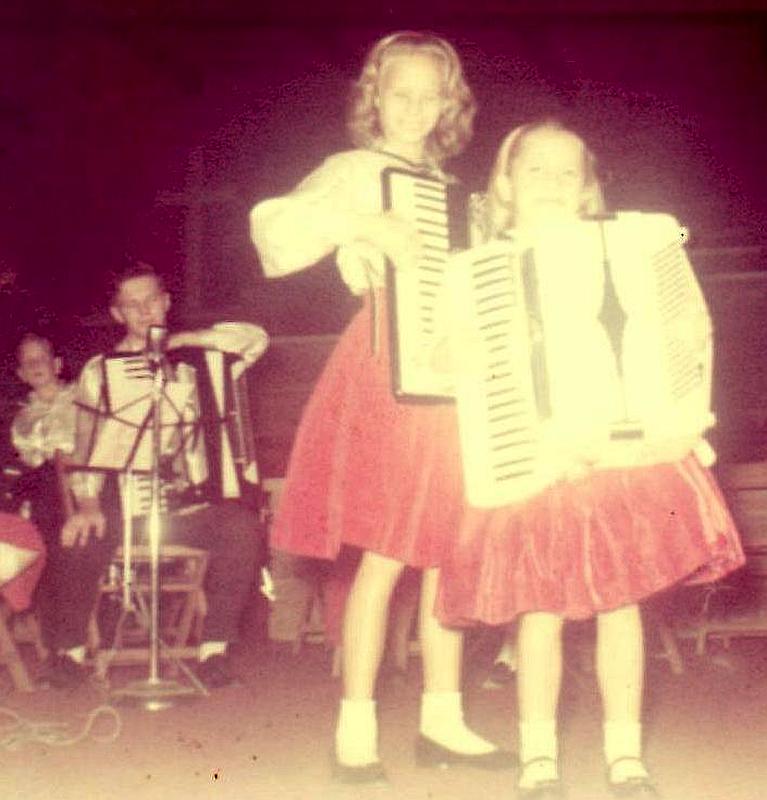
|
| Starlet Music Center Band, Karen Malan Uribe (left). |
Karen Malan-Uribe grew up in Dearborn, Michigan where her father Alan Malan owned and ran an accordion studio. Although she quit playing the accordion for a number of years, Karen never forgot the pure magic of those days. Several decades later, Karen helped to create the Washington Metropolitan Accordion Society (WMAS) and was its founding President. WMAS completely changed MY life, and I am ever so grateful to Karen for her tireless encouragement and her wonderful, innovative ideas! One of her terrific ideas was writing a book about the accordion for children. She approached me to illustrate the book and Mary Tokarski to narrate and play accordion for the book’s CD, and "An Accordion! What is that?" – a delightful and popular children’s book – was published in 2009. Karen speaks of her experiences as a young accordionist in her father's Michigan studio: "I grew up in Dearborn, Michigan in the 1950s when music was something you created yourself. It seemed like everyone played some type of instrument. We all use to sit around and sing and dance in the evenings for entertainment. I grew up listening to my dad play the accordion and loved it when he got to a song that I could sing along with and even better dance to. He had a studio in the basement of our house and gave lessons there. There came a time when the accordion band grew to about 60 kids and he opened up a studio, the Starlet Music Center. The band used to play at rest homes, children’s hospitals and churches. It was a very active time. We all wore red velvet skirts and cream satin blouses. The AAA was sort of a dream at that time. It was the place where you went to see all the famous players that you heard on the radio, and watched them perform their wonderful music pieces that you struggled as a student to play. It was magical. My most memorable time was in the 1960s when the AAA competition was in New York and the next year in Chicago. I attended both with my parents. Out of all the wonderful players, I was most impressed with Joan Cochran Sommers. Being a budding pre-teen, I looked at her as a hero -- a woman who played so fantastically! I thought, “if she can do that, then so can I”. Funny, at an AAA meeting a few years ago I mentioned it to her and she was able to recall the dress she wore and the music she played. Amazing! Yes, the AAA and the accordion world have been part of my life and I have enjoyed every minute of the time I have spent with other accordionists. They are a fantastic, fun loving bunch of people that I hope will continue to grow." |
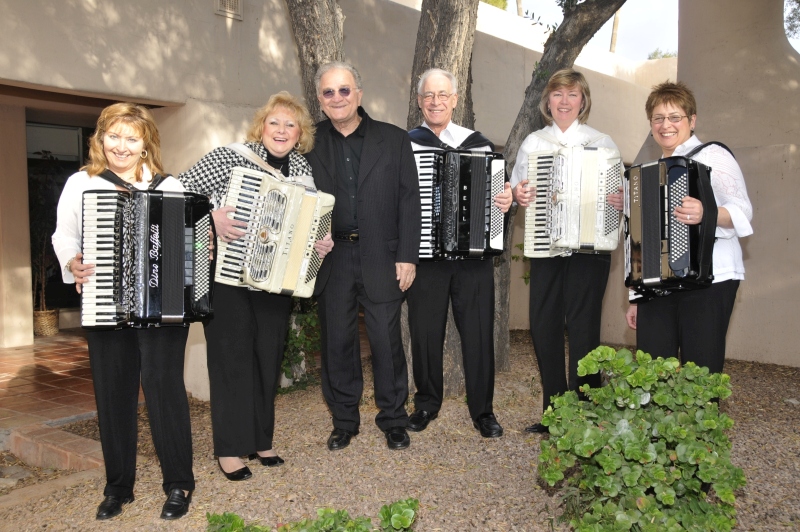 |
| (l to r) Kathy DiCocco, Karen Buccitti, Frank Marocco, Bob Vitale, Judy Sehnal, Marilyn O'Neil, 2010 Frank Marocco Accordion Event, Mesa, Arizona. |
AAA Governing Board member and chairperson of AAA’s Bob Vitale Youth Involvement Program, Marilyn O’Neil, studied accordion as a child with the late Bob Vitale. Bob, a very special person to so many of us in the accordion world, sadly passed away this past summer. I will end my article with Marilyn’s heartfelt words: "I studied accordion at Bob Vitale Music School in Waterbury, CT. It was one of the highlights of my youth. Weekly lessons with Bob were challenging, as he held high expectations of his students. All school breaks were spent at the studio where his students rehearsed in small ensembles during the day and in larger orchestras (junior and senior) in the evening. These rehearsals prepared us for concerts and state competitions. The music school served as a social hub as well as a musical home. Romance blossomed among several members of the orchestra and the studio staff. My sister dated the drum teacher and eventually married the guitar teacher at the studio! Another couple married. We clowned around as much as we practiced during our all day sessions. Bob treated us all to lunch at midday! Poor Bob had to keep a watchful eye on EVERYTHING that went on behind the stacks of accordions..... Competitions were held in New Haven and Hartford, CT over entire weekends and involved hundreds of accordion students from all over the state. These events involved competition during the day....and great fun at night. The kids were treated to dances set up just for them, with rock bands, dancing and tons of fun. Solo categories had 30-40 competitors. I always came in 4th, which was both disappointing and impressive when you think of it, since the competition was stiff. Our ensembles won consistently. We were judged by the best in the industry: Carmen Carrozza, Charles Magnante among them. The other music schools in the area were well respected. Domenic Mecca, Bob Mobilio, Rudy Molinaro and Mike Fernino presented challenges in their fine students. While the competitions were anxiety provoking for me, they also prepared me to get up in front of a large group of people and perform. It taught me the value of preparation. It taught me responsibility. It taught me to be goal oriented. It taught me the value of respecting my teacher who clearly wanted the best for all of us. We wanted to make him proud. The relationships fostered during that very special time have persisted to this day. Several former students of Vitale Music School reunited when the Connecticut Accordion Association (CAA) was formed. Bob Vitale joined us. We played alongside our teacher in the CAA orchestra as well as in an ensemble of students from Vitale Music. This reunion was a testament to the relationship we formed with Bob, who played a pivotal role in our lives both in and outside of the musical arena. It is no coincidence that he passed away last year at the same time the festival orchestra was performing in Princeton, NJ." Note from AAA Historian Joan Grauman: I just chose a few people to assist me with this article. I realize that there are many of you out there who have great stories of your years spent in the accordion bands/schools that participated in AAA events. If you have memories that you would like to share of these years, please send them to me at: graumanjoan98r@gmail.com |
|
Site
constructed and hosted by: Accordions Worldwide at www.accordionusa.com. © Copyright 2018 Accordion USA. All rights reserved |
